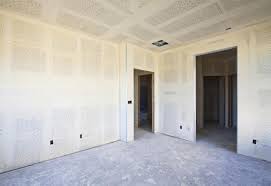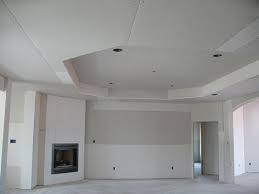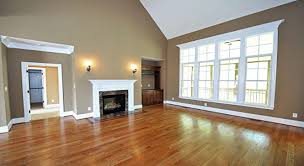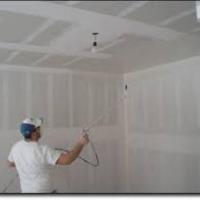Different Drywall Types and Fire Safety
by Dale Johnson on Jul 12, 2018
There are soundproof, moisture resistant, fire-resistant, and other drywall types. Check here what you need to know about drywall and fire safety.
The construction boom after the Second Great War increased the number of drywall installation projects. The relatively young gypsum product with the paper facing replaced plaster and lath due to its lower cost. Most interior walls and ceilings are drywall.

Since gypsum contains water, drywall resists fire. It slows down fire as its structure breaks down little by little. So there is no question of whether or not, the property owner will need drywall removal among other restorations. It's a question of whether there is time for people to evacuate the property before the fire spreads. And the response to this question came with new drywall types that are made specifically to be fire-resistant. So let's see which the main drywall types and the fire safety concerns are.
The typical drywall types

Drywall is classified into several big categories. So when you turn to your drywall contractor expert, define your needs. Let's elaborate. The most common drywall type is wrapped with paper. Although gypsum contains water which slows down the spread of fire, the paper facings along with the painting is flammable. In an attempt to diminish drywall damage due to increased moisture and mold growth, the manufacturers produced improved types which are distinguished by their color. The green, blue and purple boards became the dominant solutions to wet environments, like bathrooms and kitchens.
The concern with common drywall types is that although gypsum will decrease the spread of fire by 30 minutes, the flammable fascia will burn immediately and cause smoke. Now, paperless drywall has substituted paper with fiberglass and it will also slow fire from spreading fast but the best options are types x and type c drywall.
Type X drywall
This fire-resistant drywall is usually 5/8'' thick and increases fire rating from 30 minutes to 1 hour. The difference here is not just the extra thickness of the product but that the gypsum core consists of glass fibers that are noncombustible.
Type C drywall
This is the improvement of the fire code X type. The gypsum still contains glass fibers only more. It also contains other components which make it even more resistant to fire. The type C drywall has a 2-4 hour fire rating and can be 5/8'' or ½'' thick.
Type X Shaftliner drywall
This is the latest fire-resistant drywall product. Made of a noncombustible gypsum core with glass fibers, this type shows incredible resistance to fire although its fascia, edges, and back are covered by water-repellent paper.

Drywall types and fire safety concerns
It's common practice for drywall companies not to install fire-resistant products all over the house. The X Shaftliner drywall, in particular, is not used for exterior applications either and mostly in a stairwell and elevator enclosures, area separation firewalls, corridor ceilings etc. Fire-resistant drywalls are used as the walls separating the main house and garage and around the boiler.
Now, one of the most frequently asked questions on the side of homeowners is why fire resistant drywall is not used all around the house! There are two reasons for that: first, they are more expensive. Second, although they will provide the highest degree of fire safety, walls are not the only things in the house that can spread a fire. There are non-fire-rated interior doors and many flammable objects in the house that can accelerate a fire.
Of course, you are free to install fire-resistant drywall around the house. One more thing to know about fire-rated drywall is that the products must be certified by UL, ASTM or another third party. So make sure you choose the right product and always based on your needs since drywall types are classified into major categories (standard, moisture resistant, soundproof, fire-resistant etc.)
Popular Articles
Three Places to Spend Money on the Exterior of Your Home
When you have the exterior of your home remodeled, you are investing, time, energy and convenience into the project and you want to make sure that...
105558 Views
Homemade Headboards-Make an Upholstered or Wooden Headboard
Homemade headboards can add a lot of personality to any bedroom. They can be coordinated with existing furniture and room decor or they can be the...
80435 Views
When to Use a Brush, Roller or Sponge Brush
Brushes are a good choice for painting trim and woodwork. They are also useful for cutting in the edges around the top and bottom edges and corners...
73053 Views
Creating a Cottage Kitchen with Bead Board
Kitchen decor can range from modern and bold to elegant and elaborate by using strategic kitchen pieces. One of the most popular decorating trends...
58844 Views
Gas Fireplace Diagnostics and Troubleshooting
Follow these steps for diagnosing and troubleshooting Gas Fireplaces repairs. For the average DIYer, this may seem intimidating, depending on the...
35832 Views
Latest Articles
Why Professional Heat Pump Installation is Key to Maximizing Efficiency and Longevity
Heat pumps are a highly efficient means of heating and cooling homes, reducing energy costs and contributing to environmental sustainability. To...
on Dec 15, 2025
Hydro Jetting Services: Unclog Your Pipes with the Power of Water
When faced with stubborn clogs and slow drains, conventional solutions often fall short. But with the innovation of hydro jetting services,...
on Dec 15, 2025
Why Professional Boiler Repair is Essential for Home Safety and Comfort
Maintaining a warm and safe home environment is paramount for any homeowner. Your home's boiler system plays a critical role in this, but what...
on Nov 5, 2025
How to Keep Your Home Warm in the Winter
How to Keep Your Home Warm in the WinterAs winter approaches, keeping your home warm becomes a priority for comfort and health. Efficient heating...
on Oct 29, 2025
Why Reliable Furnace Repair is Essential for Winter Comfort
As the cold season approaches, homeowners recognize the critical role that a well-functioning furnace plays in ensuring a warm and cozy living...
on Oct 29, 2025
Featured Articles
What Type of Licensed Contractor Should You Hire?
on Feb 28, 2017
Hire Contractors / Estimates

Looking for a specialty project? There are many types of contractors available for your home improvement needs. Finding the right type of...
Actions
Top Categories
- Garden / Landscaping / Patio — 264
- Kitchen / Bathrooms — 240
- Real Estate / Finance — 203
- Appliance / Repair — 186
- Interior Design / Decor — 184
- HVAC / Air Conditioning — 150
- Cleaning / Maintenance — 144
- Improvements / Remodeling — 131
- Plumbing / Basements — 120
- Floors / Tile / Hardwood — 116
- Safety / Security — 114
- Doors / Garages — 113
Articles Archive
More DIY Articles
I Would Like to Do a Loft Conversion. What Do I Need to Know?
You have probably heard so much about the different benefits that loft conversion has to offer, which includes the increase in your living space,...
Texas Local Builders Associations
Find a local builder or council, please contact the home builders' association (HBA) in your area.
Four Seasons and Your Home
Regular maintenance should be performed on your heating and cooling system. Independence heating and cooling specialists must be on their toes...
Ideal Carport Plan for Homeowners
The carport is always covered at the top and opened at the sides that offer shelter to vehicles, especially cars. However, you should not confuse...
Searching for the Best Bathroom Remodeler in Your City? Here are 5 Tips
Your bathroom is one of the most important rooms in your home. It is a sanctuary where you refresh after a tiring day. This is a living space that...

